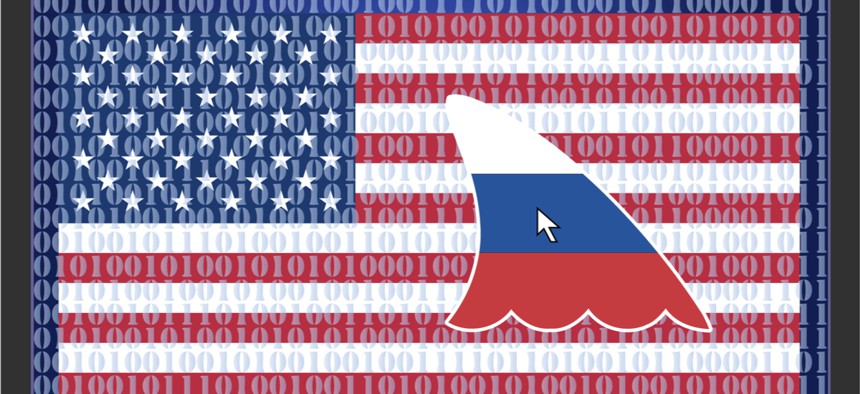Russia's Troll Operation Was Not That Sophisticated

Sangoiri/Shutterstock.com
“If the Internet Research Agency were a start-up media company, they probably would not be picking up a fresh round of venture capital.”
It might be nice for Democrats and #NeverTrumpers to believe that Russia’s troll factory brought Donald Trump the 2016 Presidential Election.
But no.
Special Counsel Robert Mueller’s indictment of 13 Russians associated with the Internet Research Agency definitively shows, given current evidence, that while a small team in St. Petersburg ran a successful audience-development campaign mostly on behalf of Trump, that campaign was neither targeted nor sizable enough to change the election’s result.
Make no mistake: This was self-described and actual “information warfare.” The point was to sow discord and distrust in the American electorate. And with a few dozen people—around 80 at the peak—they managed to reach 150 million people through Facebook and Instagram. In September 2016, the indictment states that the monthly budget of the unit that contained the U.S. election-interference operation was $1.25 million. That’s pretty good bang for the buck.
But many of the sections of Mueller’s indictment that might sound ominous to the uninitiated read like the most basic tactics in what is known as “audience development.” Maneuvers that might sound sophisticated to outsiders are widely known and practiced by every corporate advertiser and many media companies.
This is important because if the Russians were largely using off-the-shelf tactics, then we can use what we know about digital media broadly to assess how great an impact their operation had. And put it this way: If the Internet Research Agency were a start-up media company, they probably would not be picking up a fresh round of venture capital for their media skill.
Take the topline number of 150 million people. This includes those who might have seen a single ad as they scrolled on Facebook. One hundred million Americans saw the ads on during the Super Bowl, and those are multimillion-dollar commercials designed for maximum impact, not some promoted post from a Facebook page called Heart of Texas. Facebook and Instagram ads obviously work in some circumstances, but even the lowest-rent operators of online stores know that it takes a lot more than one ad out of the thousands Americans see every day to do anything.
Which is just to say: Let’s not give the Russian ads too much credit. The ones in the public domain had tiny audiences, even if they were remarkably effective at getting people to click on them. Showing a lot of people—even millions spread across the country—a couple of ads or holding some sparsely attended rallies is not what landed Donald Trump in the White House. There is nothing in the public record or indictment that indicates the efforts were large, targeted, or effective enough to sway the vote in the key states that gave Trump the victory.
Here’s what the Russian trolls did, according to the Mueller indictment (which is in line with everything that’s been publicly reported). They built medium-sized social-media pages, primarily on Facebook and Instagram. They posted to these pages regularly, usually targeting Hillary Clinton, with a mix of content.
“Defendants and their coconspirators issued or received guidance on: ratios of text, graphics, and video to use in posts; the number of accounts to operate; and the role of each account (for example, differentiating a main account from which to post information and auxiliary accounts to promote a main account through links and reposts),” the indictment reads. None of this is magic. Many media companies from HuffPost to Blavity would be familiar with trying to optimize the type of posts going out on a page or set of pages. In a quick scan, HuffPostmaintains more than 50 Facebook pages, the main one and dozens of auxiliary ones in different languages and on specific topics. And they coordinate action across them.
The Russians tracked how well what they were posting was connecting with people. “In order to gauge the performance of various groups on social-media sites, the ORGANIZATION tracked certain metrics like the group’s size, the frequency of content placed by the group, and the level of audience engagement with that content, such as the average number of comments or responses to a post,” the indictment reads. And in another spot: “Defendants and their coconspirators received and maintained metrics reports on certain group pages and individualized posts.”
This is not high-level spy craft. It is, rather, bread-and-butter audience-development work. My guess here is that they simply looked at Facebook analytics. It’s one click in the Facebook interface to look at these numbers.
And finally, they reached out to social-media influencers to promote their events, which by all accounts were at best mildly successful. “Defendants and their coconspirators contacted administrators of large social-media groups focused on U.S. politics and requested that they advertise the rallies,” the indictment says. The practice of big social-media pages trading (or even buying/selling) posts is widely practiced. They’re often called “partnerships” in the audience-development game.
This all sounds like a messy, Rube Goldbergian way to deliver people news, entertainment, and propaganda on the internet, but it is how distribution has worked since Facebook became a major player in the news ecosystem five years ago.
Facebook is largely responsible for the widespread use of all these tactics. They built the system that the media had to live in to survive. The system treats all “content” the same, which means that regular people, media companies, activists, and advertisers fight tooth and nail for attention within the News Feed. For companies, that attention is, eventually, linked to revenue, so brands and media outfits dedicated substantial attention to honing all these practices. Now, there is a spectrum, running from “even The New York Times would do it,” through influencer marketing, and down to the scummiest almost-fraud tactics. On that continuum, the Russian campaign seems pretty vanilla.
And as for the secrecy and traceability of the effort, the foreign-affairs analyst Vladimir Frolov described it to The Times as “very ad hoc, very amateurish.”
I’d take the audience-development teams at BuzzFeed, Arby’s, or JetBlue over the Internet Research Agency any day of the week. It is not hard to imagine a far better campaign to have actually tried to throw the election. For example, the Russians could have targeted electorally crucial areas within certain battleground states. Instead, as we learned at a Senate hearing in November, “the total amount spent targeting Wisconsin was a mere $1,979; all but $54 was spent prior to the completion of the primary, and none of the ads even mentioned Trump. The spending in Michigan and Pennsylvania was even smaller.”
Mueller’s indictment even suggests that the Russian operatives were not familiar with the term “purple state” until they talked with somebody in Texas in June of 2016. “After that exchange,” the indictment says, “Defendants and their coconspirators commonly referred to targeting ‘purple states’ in directing their efforts.”
This analysis, of course, is based on extant evidence. Worse things could be found.
And none of this is to say that Mueller won’t discover something in the Russian scheme that will end up implicating one or more members of the Trump campaign or even the President himself. Recall that Watergate revolved around a silly, bungled, and unnecessary wiretapping misadventure that occurred during an election in which Richard Nixon won 60.7 percent of the popular vote and 520 of 537 electoral votes.
A medium-sized hustle to mess with the American presidential election on behalf of the Russian oligarchy could lead anywhere. But from the looks of things, it was Americans who put Donald Trump in the White House.






